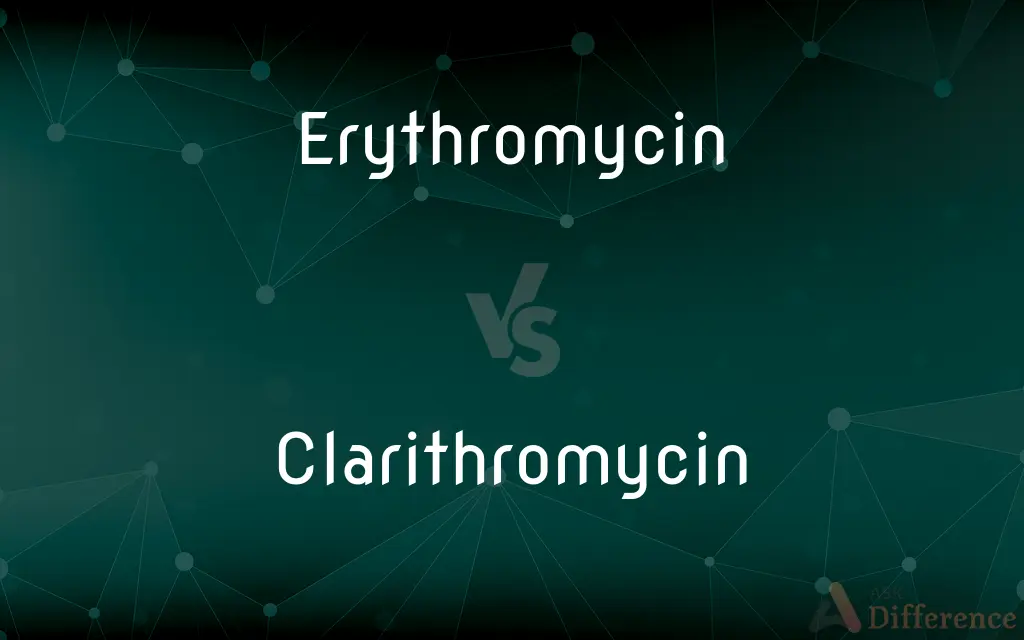Erythromycin vs. Clarithromycin — What's the Difference?
By Fiza Rafique & Maham Liaqat — Updated on April 24, 2024
Erythromycin is a broad-spectrum antibiotic effective against a variety of bacterial infections, while clarithromycin offers enhanced acid stability and a longer half-life, making it more potent against respiratory pathogens.

Difference Between Erythromycin and Clarithromycin
Table of Contents
ADVERTISEMENT
Key Differences
Erythromycin, introduced in the 1950s, is one of the older antibiotics in the macrolide class, effective against a wide range of bacterial infections, including respiratory and skin infections. Clarithromycin, developed later, is a semi-synthetic derivative of erythromycin, designed to overcome some of the limitations of its predecessor, such as acid instability and gastrointestinal side effects.
The absorption of erythromycin is significantly affected by stomach acids, which can reduce its effectiveness. Clarithromycin, however, has improved acid stability, allowing for better absorption and efficacy when taken orally. This makes clarithromycin more suitable for treating infections where a higher and more sustained concentration of antibiotic is beneficial, such as in cases of chronic bronchitis and sinusitis.
Erythromycin has a shorter half-life, which typically necessitates more frequent dosing, usually three to four times a day. In contrast, clarithromycin's longer half-life supports twice-daily dosing, improving patient compliance with the treatment regimen. Additionally, clarithromycin's longer duration of action allows it to maintain effective drug levels in the blood for a longer period.
The spectrum of activity for both antibiotics is broad, targeting a variety of Gram-positive and some Gram-negative bacteria. However, clarithromycin is generally more effective against certain respiratory pathogens, including Mycoplasma pneumoniae and Helicobacter pylori, the latter of which is often associated with stomach ulcers.
In terms of side effects, both erythromycin and clarithromycin can cause gastrointestinal issues, such as nausea and diarrhea, due to their effect on motilin receptors. However, these effects tend to be more pronounced with erythromycin, while clarithromycin is often better tolerated, partly due to its modified chemical structure which reduces motilin receptor stimulation.
ADVERTISEMENT
While both antibiotics can interact with other medications, erythromycin is known for a higher potential for drug interactions, particularly with drugs metabolized by the cytochrome P450 enzyme system. Clarithromycin, though also metabolized by this system, typically has fewer severe interactions, but caution is still advised, especially with medications affecting cardiac rhythm.
Comparison Chart
Introduction Year
1950s
Developed later as a derivative of erythromycin
Acid Stability
Lower, affected by stomach acids
Higher, more stable in acidic conditions
Half-life
Shorter, requires frequent dosing
Longer, allows for less frequent dosing
Effective Against
Broad range of bacteria, including skin infections
Especially effective against respiratory pathogens
Dosage Frequency
Typically three to four times daily
Typically twice daily
Side Effects
More pronounced gastrointestinal issues
Better tolerated, fewer gastrointestinal effects
Drug Interactions
Higher potential for interactions
Fewer severe interactions
Compare with Definitions
Erythromycin
A broad-spectrum antibiotic used to treat various bacterial infections.
Erythromycin is prescribed for treating whooping cough.
Clarithromycin
A semi-synthetic macrolide antibiotic with a longer half-life and improved acid stability.
Clarithromycin is effective in treating bronchitis.
Erythromycin
Can cause gastrointestinal side effects due to motilin receptor stimulation.
She experienced stomach upset after taking erythromycin.
Clarithromycin
Requires less frequent dosing, improving patient compliance.
Clarithromycin is taken twice daily, making it easier to follow the regimen.
Erythromycin
Requires more frequent dosing due to its shorter half-life.
Erythromycin needs to be taken four times a day.
Clarithromycin
Often used to treat infections caused by Helicobacter pylori.
To eradicate H. pylori, a combination of clarithromycin and other antibiotics was used.
Erythromycin
Used as a first-line treatment in patients allergic to penicillin.
Erythromycin was administered because the patient had a penicillin allergy.
Clarithromycin
Has fewer severe drug interactions than erythromycin.
Clarithromycin was chosen due to its lower risk of interacting with her other medications.
Erythromycin
Known for its role in treating respiratory tract and skin infections.
He was given erythromycin for his severe acne.
Clarithromycin
Less likely to cause severe gastrointestinal issues compared to erythromycin.
He tolerated clarithromycin better than erythromycin.
Erythromycin
Erythromycin is an antibiotic used for the treatment of a number of bacterial infections. This includes respiratory tract infections, skin infections, chlamydia infections, pelvic inflammatory disease, and syphilis.
Clarithromycin
Clarithromycin, sold under the brand name Biaxin among others, is an antibiotic used to treat various bacterial infections. This includes strep throat, pneumonia, skin infections, H. pylori infection, and Lyme disease, among others.
Erythromycin
An antibiotic, C37H67NO13, obtained from a strain of the actinomycete Saccharopolyspora erythraea and used chiefly to treat infections caused by gram-positive bacteria.
Clarithromycin
A macrolide antibiotic, C38H69NO13, used to treat a variety of bacterial infections, especially of the respiratory tract.
Erythromycin
(pharmaceutical drug) A broad-spectrum macrolide antibiotic C37H67NO13 produced by an actinomycete Saccharopolyspora erythraea (formerly Streptomyces erythreus) and similar in its effects to penicillin, administered orally or topically in the treatment of infections caused by Gram-positive bacteria.
Clarithromycin
(pharmaceutical drug) A semisynthetic macrolide antibiotic C38H69NO13 (trademarks Biaxin, Klaricid) used especially in the treatment of various mild to moderate bacterial infections.
Erythromycin
An antibiotic (trade name Erythrocin or E-Mycin or Ethril or Ilosone or Pediamycin) obtained from the actinomycete Streptomyces erythreus; effective against many Gram-positive bacteria and some Gram-negative
Common Curiosities
Why is clarithromycin preferred over erythromycin for respiratory infections?
Clarithromycin's improved acid stability and longer half-life make it more effective against respiratory pathogens, maintaining higher and more sustained drug levels.
Can both erythromycin and clarithromycin treat skin infections?
Yes, both antibiotics can treat skin infections, but erythromycin has a longer history of use for this purpose.
What is the main chemical difference between erythromycin and clarithromycin?
Clarithromycin is a semi-synthetic derivative of erythromycin, modified to improve acid stability and half-life.
What are the common side effects of erythromycin and clarithromycin?
Both can cause gastrointestinal issues like nausea and diarrhea, but erythromycin is generally associated with more pronounced side effects.
How do erythromycin and clarithromycin interact with other drugs?
Both can interact with drugs metabolized by the cytochrome P450 system, but erythromycin has a higher potential for significant interactions.
Which is more suitable for patients with stomach ulcers?
Clarithromycin is often used in combination with other drugs to treat Helicobacter pylori infections associated with stomach ulcers.
What is the dosage adjustment for patients with kidney disease?
Dosage adjustments may be necessary for both antibiotics in patients with severe renal impairment.
How long does it take for erythromycin and clarithromycin to start working?
Both antibiotics usually begin to work within a few days, but the full course should be completed to prevent bacterial resistance.
Are erythromycin and clarithromycin safe for pregnant women?
Both antibiotics are generally considered safe during pregnancy, but as with all medications, they should only be used when clearly needed and under the supervision of a healthcare provider.
Can either antibiotic be used in pediatric patients?
Yes, both erythromycin and clarithromycin can be used in children, with dosages adjusted based on weight and the specific infection being treated.
Share Your Discovery

Previous Comparison
Hahaha vs. Bahaha
Next Comparison
Sisterhood vs. SororityAuthor Spotlight
Written by
Fiza RafiqueFiza Rafique is a skilled content writer at AskDifference.com, where she meticulously refines and enhances written pieces. Drawing from her vast editorial expertise, Fiza ensures clarity, accuracy, and precision in every article. Passionate about language, she continually seeks to elevate the quality of content for readers worldwide.
Co-written by
Maham Liaqat













































